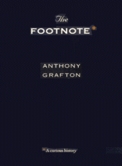
| Publisher: | Harvard |
| Copyright: | 1997 |
| Printing: | 1999 |
| ISBN: | 0-674-30760-7 |
| Format: | Trade paperback |
| Pages: | 235 |
Even with some advance warning, this wasn't quite the book I was expecting from the title. I'm curious about typography, punctuation, and how one lays out text in English for maximum effectiveness. I thought this book would include some discussion of the history of the footnote as a typographic convention and the bizarre abbreviations and language used in them. That's not Grafton's topic at all; The Footnote does include some minor discussion of footnotes versus endnotes, but for the most part he ignores the typographic possibilities entirely.
Instead, this is a history of (or a collection of musings on) source references in published historical books and papers. The topic is not the footnote as a presentation artifact but rather the footnote as an approach to presenting scholarship.
Once I made the necessary mental shift, this is an intriguing topic. Classical scholars did not heavily footnote, did not (in Grafton's terms) show the infrastructure of their work. They made reference to other works, but did not rely on them for evidence. A similar attitude prevailed in the Renaissance, where (in a particularly memorable turn of phrase) scholarship, like riding, should appear effortless and the purpose of the scholar is to show the conclusions in a compelling narrative without drowning the reader in supporting material. The modern paper (of which this book is an excellent example) is, in contrast, packed to the gills with infrastructure. It's not uncommon for footnotes to take up half a page in The Footnote, not with asides or commentary but with exhaustive references to related works or the original text of comments that are presented translated in the main work.
The evolution from the classical style of a clean, uncluttered narrative argued on its own terms and through the authority of the author to the modern desire for each statement to be supported and for the basis of the research to be visible and available to the reader is more than an evolution of style. It accompanies changes in the availability of books, which allow authors to write accurate citations from books on hand rather than relying on memory. Those citations are also more useful for the reader who has greater access to the original material. Behind the story of footnotes is also the evolution of emphasis on original source material. Meticulous footnotes, or even inclusion of complete copies of the original source material, allow and encourage the reader to redo the research of the author and verify their conclusions.
Grafton started to win me away from my disappointment with a capsule history of this evolution, but the tone and structure of this book continued to get in my way. Grafton tells his history oddly backwards and sideways, starting with Ranke and then moving back in time, which didn't help give me a sense of changes over time. I frequently lost track of what era Grafton was talking about in a given section, and Grafton rarely felt the need to remind me. Ironically, the footnotes didn't help at all, since even the dates of the writings of the time were from the modern edition or reprinting rather than the original date of the work (another controversy about footnotes and citations that Grafton didn't mention).
I got from this book the summary above, a sense of the importance of citation to how historians think about their work, and a few landmark figures of history, but most of it was a slog. I fear many pages blurred together and fell out of memory due to lack of background, lack of a clear chronological structure into which to embed them, and lack of a narrative structure to make them compelling. Doubtless it brands me a philistine to say so, but I think this would have been a better book if Grafton had started at the beginning and written through to the end instead of following his own line of thought from Ranke backwards. His structure may work for someone who already knows the players and dates, but for the uninitiated it's quite confusing.
Despite the praise this book has gotten outside of an academic context, it's not a popularization and I think is primarily of interest to people already curious about source citations, the culture and connections attested to by scholarly footnotes, and the evolution of the attitude towards source material over time. Coming at it from outside, with little more than introductory college history, it didn't hook me; I found it dry and unnecessarily non-linear. It offered some memorable insights into historians that I'm glad to have (footnotes as defense against heresy or political challenge, insult by ommission of reference, identification of school or approach from the works cited), but the effort to get at those insights was high.
I'd still like to read a book on the topics Grafton didn't tackle: the fights over citation style; evolution and use of such abbreviations as ibid., op. cit., and cf.; footnotes versus endnotes versus marginal notes and the presence or absence of a bibliography (Grafton omits one but doesn't comment on it); typographical challenges to setting, wrapping, marking, and distinguishing footnotes; dating of works in references (Clute has some pointed things to say about this); and the use and abuse of footnotes outside of a purely academic context.
Reviewed: 2007-01-28